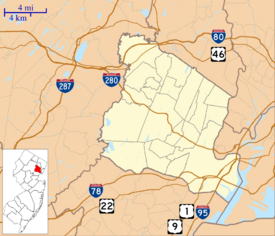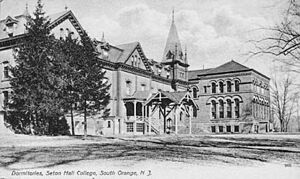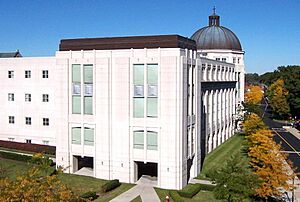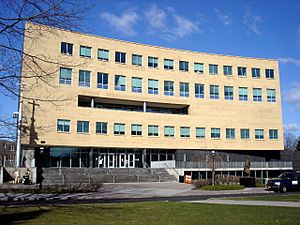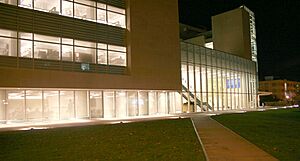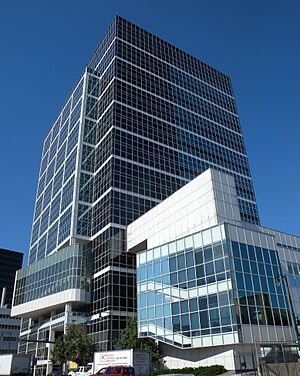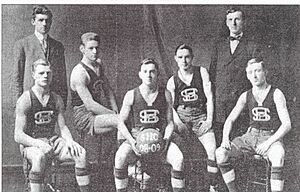Seton Hall University facts for kids
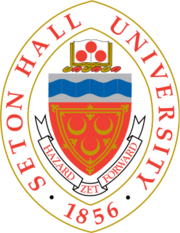 |
|
|
Former name
|
Seton Hall College (1856–1950) |
|---|---|
| Motto | Hazard Zet Forward (Norman French/English) |
|
Motto in English
|
"Despite hazards, move forward" |
| Type | Private research university |
| Established | September 1, 1856 |
| Founder | James Roosevelt Bayley |
| Accreditation | MSCHE |
|
Religious affiliation
|
Catholic Church (Diocesan) |
|
Academic affiliations
|
|
| Endowment | $308.4 million (2022) |
| Budget | $305.1 million (2020) |
| President | Joseph R. Reilly |
| Provost | Katia Passerini |
|
Administrative staff
|
1,065 |
| Students | 9,529 (fall 2023) |
| Undergraduates | 6,109 (fall 2023) |
| Postgraduates | 3,420 (fall 2023) |
| Location |
,
,
United States
40°44′30″N 74°14′42″W / 40.7417°N 74.2449°W |
| Campus | Large suburb, 58 acres (0.2 km2) |
| Newspaper | The Setonian |
| Other campuses | Newark |
| Colors | Pirate blue, gray, and white |
| Nickname |
|
|
Sporting affiliations
|
|
| Mascot | Pirate |
| Website | shu.edu |
 |
|
Seton Hall University (often called SHU) is a private Catholic research university located in South Orange, New Jersey, United States. It was started in 1856 by Bishop James Roosevelt Bayley. The university is named after his aunt, Saint Elizabeth Ann Seton. Seton Hall is the oldest university in the U.S. that was founded by a diocese.
Seton Hall has 9 different schools and colleges. About 5,800 undergraduate students and 4,400 graduate students attend the university. It is known for its high level of research activity.
The university is also famous for its men's basketball team. The team has played in the NCAA Division I men's basketball tournament 13 times. In 1989, they made it to the championship game but lost in overtime. This success helped the university become more well-known.
Contents
Discovering Seton Hall's Past
How Seton Hall Began
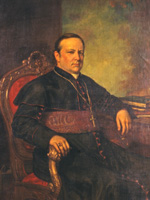
Like many Catholic universities, Seton Hall was created to help bring Catholic education to higher learning. The Archdiocese of Newark was formed in 1853. Just three years later, Seton Hall College officially opened on September 1, 1856.
Bishop James Roosevelt Bayley founded the college. He was a cousin of Franklin Roosevelt, who later became a U.S. president. Bishop Bayley named the school after his aunt, Mother Elizabeth Ann Seton. She was the first American-born Catholic saint.
The first campus was in Madison, New Jersey. Reverend Bernard John McQuaid was the first president. He led a small team of teachers. Seton Hall started with only five students. By the end of the first year, there were 60 students. The college moved to its current location in South Orange in 1860.
Growth and Challenges
Seton Hall College grew quickly in the 1860s. However, fires on campus sometimes slowed things down. In 1867, a fire destroyed the first college building. Another fire in 1886 ruined the main building. In 1909, a classroom and some dorms also burned down.
Despite these challenges and tough financial times, the college kept growing in the 1800s. In 1893, Seton Hall started a military science department, which was similar to today's ROTC program. A big change happened in 1897 when the high school part of Seton Hall became separate from the college.
Becoming a University
In 1936, James F. Kelley became president of Seton Hall College. He was only 33 years old, making him the youngest college president in the country. When he started, the school had 300 students.
In 1937, Seton Hall began allowing women to attend classes for the first time. The university became fully coeducational (meaning both men and women could attend all programs) in 1968. In 1948, Seton Hall started its own radio station, WSOU-FM. The Walsh Gymnasium was also built around this time.
The college officially became a university in 1950 because so many students were joining. It then included the College of Arts and Sciences, and schools for business, nursing, and education. The School of Law opened in 1951. Miriam Rooney became the first woman dean of law in the United States.
Modern Campus and Growth
From the late 1960s through the 1980s, Seton Hall built many new facilities. These included the library, science buildings, student dorms, and the university center. Many new study programs were also started.
In 1984, the Immaculate Conception Seminary returned to Seton Hall. The Recreation Center opened in 1987. More dorms were built between 1986 and 1988, allowing more students to live on campus. Seton Hall is now known as a residential campus, meaning many students live there.
Campus development continued in the 1990s. The $20 million Walsh Library opened in 1994. This library brought many new study and research tools to the university. Today, the university library has over 500,000 books and other resources.
In 1997, the university opened a new academic building called Jubilee Hall. It is home to the Stillman School of Business. The recreation center was also renamed for athletic director Richie Regan.
Safety Improvements
On January 19, 2000, a fire happened in Boland Hall, a freshman dorm. Three students sadly passed away, and 54 were hurt. This event led to much stronger fire safety rules at the university. Students created "The Remember Seal" in front of Boland Hall to honor those affected.
Celebrating 150 Years
For its 150th anniversary (1856–2006), Seton Hall started a fundraising campaign called "Ever Forward." The goal was to raise $150 million to improve campus buildings and historic sites.
In 2007, the university opened a new $35 million Science and Technology Center. This was a big part of the campaign. By December 2007, the university had successfully reached its fundraising goal.
Recent Developments
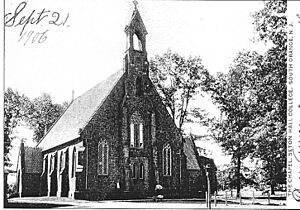
Since 2010, Seton Hall has continued to update its campus and attract more students. Around $100 million was spent on improvements that finished in 2014. These included a new fitness center, an academic building, a parking garage, and an expanded dorm.
In 2015, Seton Hall created two new academic areas: the School of Medicine and the College of Communication and the Arts. The medical school started with its first class in 2018. In 2020, the medical school became an independent school. The College of Communication and the Arts was previously a department before becoming its own college.
How Seton Hall is Managed
Seton Hall University is managed by a group called the board of trustees. This board has 16 members. The Archbishop of Newark is the president of the board. The board of trustees owns the university's property and decides where schools and colleges will be located.
Another group, the board of regents, helps manage the university. This board has between 25 and 39 members. The regents are in charge of hiring the university president.
Exploring the Campus
Main Campus Features

Seton Hall University's main campus covers 58 acres in South Orange, New Jersey. Most of the university's schools and colleges are here. The village center is a short walk from campus. The campus has different building styles, including Roman, neo-Gothic, and modern designs. The South Orange campus became a gated community during the university's modernization.
Important Buildings
The campus has many interesting buildings, some of which are very old:
- Presidents Hall – This is one of the oldest and most important buildings on campus, finished in 1867. It's a beautiful brownstone building with a neo-Gothic style. It used to be a seminary but now holds the university's main offices, including the President's Office. Inside, you can see portraits of past university presidents and a large stained glass window showing Saint Elizabeth Ann Seton.
- Chapel of the Immaculate Conception – This lovely Gothic Revival brownstone chapel was built in 1863. It has been updated several times, most recently in 2008. It's considered one of the most beautiful college chapels.
- Muscarelle Hall (formerly Stafford Hall) – This new academic building opened in 2014 on the site of an older building. It has 12 modern classrooms of different sizes. It was renamed in 2021 to honor Sharon and Joseph L. Muscarelle Jr.
- McQuaid Hall – Built around 1900, this building is named after Bishop Bernard J. McQuaid, Seton Hall's first president. It used to be a boarding house and a convent. Today, it houses the School of Diplomacy and International Relations and the School of Health and Medical Sciences.
- Jubilee Hall – This building is home to the W. Paul Stillman School of Business. It also has the largest auditorium at the university, computer labs, and modern classrooms. It was built in 1997.
- Walsh Gymnasium – This arena opened in 1939 and can seat 2,600 people. It used to be the home court for the men's basketball team. Now, it hosts the women's basketball and volleyball teams. It's part of the Richie Regan Recreation and Athletic Center.
- The Science and Technology Center (formerly McNulty Hall) – Built in 1954, this building was originally named for Msgr. John L. McNulty, a former university president. It's the university's technology and research center. A famous feature is the Atom Wall, which shows scientific knowledge being given to humans. The building also has an amphitheater and an observatory for science classes.
- Fahy Hall – Built in 1968, this building holds classrooms and offices for the College of Arts and Sciences. It has student resources like television studios, amphitheaters, and labs for computing and languages.
- Arts and Sciences Hall and The Nursing Building – This building, built in 1973, now houses the College of Arts and Sciences in one part and the Caroline D. Schwartz College of Nursing in another. The College of Nursing has advanced teaching facilities, including practice areas that look like hospital rooms.
- Bethany Hall – The newest building on campus, Bethany Hall, opened in 2018. It's also called the Welcome Center and has space for events and admissions offices.
Green Efforts
Seton Hall has a strong recycling program. Recycling is required on campus because of New Jersey state laws. The university also celebrates Earth Day with events like demonstrations on composting and rainwater collection. In 2011, Seton Hall received a "B−" grade on the College Sustainability Report Card for its environmental efforts.
Other Campuses
- Newark Campus – This campus is in downtown Newark, New Jersey, and is home to the university's School of Law. The Law School is in a modern 22-story building that opened in 1991. The Law School was founded in 1951. Miriam T. Rooney was its first dean and the first woman dean at an ABA-accredited law school in the U.S.
- Interprofessional Health Sciences Campus (IHS) – Located in Nutley, New Jersey, this campus is for students who want to work in health professions. It houses the School of Health and Medical Sciences and the College of Nursing.
What Students Learn
Seton Hall University offers many different degrees in about 70 academic subjects. The university has nine main academic units:
- College of Arts and Sciences (since 1856)
- Immaculate Conception Seminary School of Theology (since 1860)
- College of Nursing (since 1937)
- W. Paul Stillman School of Business (since 1950)
- School of Law (since 1951)
- School of Health and Medical Sciences (since 1987)
- Division of Continuing Education and Professional Studies (since 2005)
- School of Diplomacy and International Relations (since 1997)
- College of Human Development, Culture, and Media (since 2022) – This college was formed by combining the College of Communication and the Arts and the College of Education and Human Services.
University Rankings
| USNWR National University | 137 |
|---|---|
| Washington Monthly National University | 303 |
| Forbes | 215 |
U.S. News & World Report ranked Seton Hall University as tied for 165th among "National Universities" in 2025. The Seton Hall University School of Law was ranked tied at 70th best in the U.S. in 2022. The Stillman School of Business was ranked 65th among undergraduate business schools by Bloomberg Businessweek in 2016.
Student Life at Seton Hall
| Race and ethnicity | Total | ||
|---|---|---|---|
| White | 51% |
|
|
| Hispanic | 18% |
|
|
| Asian | 11% |
|
|
| Black | 8% |
|
|
| Other | 8% |
|
|
| Foreign national | 3% |
|
|
| Economic diversity | |||
| Low-income | 26% |
|
|
| Affluent | 74% |
|
|
Student Groups
Seton Hall has 24 recognized fraternity and sorority chapters. About 15% of students are part of these Greek-letter organizations.
There are also a cappella singing groups:
- The Gentlemen of the Hall (all male)
- Seton Notes (co-ed)
Student News and Media
The main student newspaper is The Setonian. It covers school news, entertainment, sports, and opinions. Students write and publish it weekly. The Stillman Exchange is the business school's newspaper, covering business and ethical topics.
The Journal of Diplomacy and International Relations is published twice a year and features articles by international leaders. Diplomacy students also publish The Diplomatic Envoy, which covers international news. The Liberty Bell is an independent political newspaper that focuses on personal freedom.
WSOU is the university's college radio station, broadcasting at 89.5 MHz FM. In 2007, it was ranked as one of the best college radio stations in the nation.
University Traditions
The University Seal
The university seal combines symbols from the Bayley family and the Seton family. The Seton family crest is very old and represents Scottish nobility. The seal has three crescents and three red circles. The motto on the seal, Hazard Zet Forward, means "Despite hazards, move forward." Students have a tradition of avoiding stepping on an engraving of the seal on the university green. It's said that if you step on it, you won't graduate on time!
Alma Mater
The Seton Hall University Alma Mater is the official song of the university. Charles A. Byrne, a student from the class of 1937, wrote the lyrics in 1936. The university adopted the song in 1937. Some students like to say "blue and white" louder than the rest of the song.
Seton Hall Sports Teams
The sports teams at Seton Hall are called the Pirates. They compete in the NCAA's Division I and are part of the Big East Conference. The first basketball team was formed in 1903.
Seton Hall is most famous for its men's basketball program. They won the 1953 National Invitation Tournament (NIT). In the 1989 NCAA tournament, they were the national runners-up, losing a close game to Michigan in overtime. Seton Hall has had the most wins in March Madness among New Jersey teams.
Seton Hall also has varsity teams in baseball, women's basketball, men's and women's cross country running, men's and women's golf, men's and women's soccer, softball, men's and women's swimming & diving, women's tennis, and women's volleyball.
The university also has club sports teams, including ice hockey, rugby union, lacrosse, and men's volleyball and soccer. Most Seton Hall sports teams play on the South Orange campus. However, the men's basketball team plays at the Prudential Center in Newark, New Jersey.
Seton Hall had a varsity football team from 1882 to 1932. They also had a club football team from 1965 to 1972, which won a national club championship. The varsity football program was brought back in 1973 but was eventually stopped permanently after the 1981 season.
Famous People from Seton Hall
Many notable people have studied or worked at Seton Hall University.
See also
 In Spanish: Universidad Seton Hall para niños
In Spanish: Universidad Seton Hall para niños


